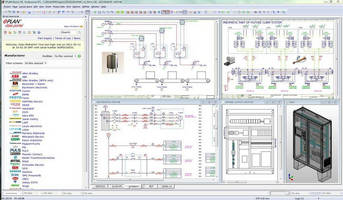Powerful CAE Software Solution Is Driving Productivity Gains
Share:

Computer-aided engineering (CAE) software is the designer´s best friend, a tool proven to enhance the user´s productivity. It has liberated engineers from the most tedious aspects of their jobs, shortened project turnaround times and improved the quality and accuracy of their work. Today´s advanced electrical CAE (E-CAE) programs have automated many tasks, such as wire numbering and device tagging. Engineers are completing assignments that once took days or weeks in a fraction of the time. The latest generation of CAE programs such as EPLAN adds a powerful central database that enables them to provide substantial additional automation. This database can hold a large archive of recurrent content, ready for insertion into a project with a single keystroke. Engineers can convert project documentation into different languages or regional, national and international standards. This makes the database-centric CAE well suited for cross-country and cross-border collaborations or for serving a multinational customer base.
Improving Accuracy
The database-driven CAE delivers a systematic reduction of errors, error-checking and data redundancy. Few, if any, errors survive to the manufacturing stage or beyond, where they´re significantly more costly to fix.
Leveraging Recurrent Content
Storing and reusing data opens the way to standardizing and modularizing product content. This accelerates design and manufacturing, and enables large economies of scale in purchasing components. The benefits of standardization are so great that some companies redesign existing models to maximize standard content so design and manufacturing for subsequent orders take less time. Others invest considerable resources creating large content archives as part of their transition to a database-driven CAE. The archive can store frequently used components or complex macros of product assemblies and subassemblies, all pre-validated.
Creating Efficiencies
The database can be integrated into a company´s IT architecture, allowing other departments to monitor a project´s progress for more accurate customer quotes, more timely and cost-effective stocking of components, and more reliable production and delivery scheduling.
Streamlining Interaction with Stakeholders
Project files can be exported to customers and re-imported with changes to speed up revisions and approvals. They also can be exported to subcontractors to shorten delivery times. Engineers can import component data directly from vendor catalogues.
3D Prototyping
Merging data with 3D modeling software lets engineers create virtual prototypes to prove a design before manufacturing. Mechatronic engineering requires smooth connectivity between mechanical engineering and all other engineering disciplines.
Superior Machine Setups
Automated setups of wire processing and enclosure manufacturing machines turn around orders faster, and with precise results.
Interdisciplinary Design as Needed
Most CAE systems are discipline specific. The EPLAN Platform with its integrated product platform supports design software for electrical as well as other engineering disciplines. In effect, the EPLAN Platform becomes a powerful multidisciplinary platform. Traditionally, engineering disciplines work separately, often with different software tools, passing a project back and forth as content is added or changed. When a process engineer adds a pneumatic-controlled butterfly valve to a design, the fluid engineer must add the fluid drive and the electrical engineer must provide control for it. Working separately, each designer´s intent is self-referencing, and colleagues might not understand it. If those same engineers work together on a project as part of a multidisciplinary team and use the integrated product platform of EPLAN, they get greater speed and accuracy and a high degree of assurance their contributions fit well together. Data is shared across all disciplines. As changes are made, the system makes updates automatically wherever those changes occur or otherwise affect the project. In addition, revisions management has been streamlined.
Maximum speed and easy search and find of component data
EPLAN´s innovation for up-to-date component data accessibility is the Data Portal, a single-source web-based library of certified parts data from the world´s leading manufacturers. It lets engineers import component data directly into projects. The data is always current, tested and verified free of errors. Users no longer need to leaf through multiple vendor catalogs to search for the right parts - another low-value use of an engineer´s time. More than 40 manufacturers with in total more than 180.000 devices are included and frequently used by engineers with more than nine million downloads so far.
Quality Improvements in Maintenance Engineering
Traditionally, the process of obtaining customer revisions and applying them is prone to delay, which can disrupt production schedules. With modern CAE systems like EPLAN, project documentation can be exported to customers in formats such as smart PDFs, and their changes are reimported and incorporated automatically. Once a design is finalized, the CAE automatically generates a complete build package for manufacturing that includes all diagrams, lists and component IDs, and if desired, automated setups for NC machining and wire processing. The maintenance technician in the field similarly is empowered. Product data typically is available in multiple electronic formats, suitable for continuous updating. Engineers can access project PDFs on a laptop or tablet for quick and mobile troubleshooting and resolution.
The EPLAN viewing tool can be connected to the visualization tool running in the control room. That´s a far cry from arriving at a customer location to find the machine´s printed manual missing, damaged or hopelessly out of date.
Fostering international collaboration
Corporations with multiple locations around the world often end up using different design tools due to decentralization of engineering operations. Replacing various legacy systems with a single advanced CAE solution like EPLAN enables seamless data transfers and real-time collaboration by teams that are geographically separated, resulting in a more efficient use of a company´s human and software assets. EPLAN transcends geography and language barriers by automatically converting projects to different languages and output formats, making it easier to collaborate with colleagues, customers, and suppliers in different parts of the world and bring projects to a conclusion faster.
EPLAN Software & Service
EPLAN Software & Service develops engineering solutions that accelerate the engineering process. Interdisciplinary expert systems ensure a maximum of productivity and data continuity. The solution provider develops tailor-made PDM and PLM concepts and provides comprehensive services such as customizing, consulting and training. Success factors are innovative development competence, a consistently practical approach and international presence. EPLAN is a subsidiary of Rittal International and thereby part of the Friedhelm Loh Group, with 11,500 employees worldwide, and an expected revenue of 3.14 Bn. Euros for 2011. EPLAN represents continuity and investment security. The seven German EPLAN branches and a presence in 50 countries support 19,500 customers with 65,000 installations worldwide. 'Efficient Engineering' - the corporate motto, underlines the proficiency of optimized, efficient processes, which support companies in their quest to stay competitive in the long term.
www.eplanusa.com
EPLAN Software & Services LLC.
37000 Grand River Ave., Suite 380
Farmington Hills, MI 48335
USA
KNAPIK Christine
Phone: +1-630-408-3863
Fax: +1-248-945-9210
Knapik.c@eplanusa.com
EPLAN Software & Service GmbH & Co. KG
An der alten Ziegelei 2
40789 Monheim am Rhein
Deutschland
ZINK Markus
Phone: +49 2173 3964-129
Fax: +49 2173 3964-613
Zink.M@eplan.de




